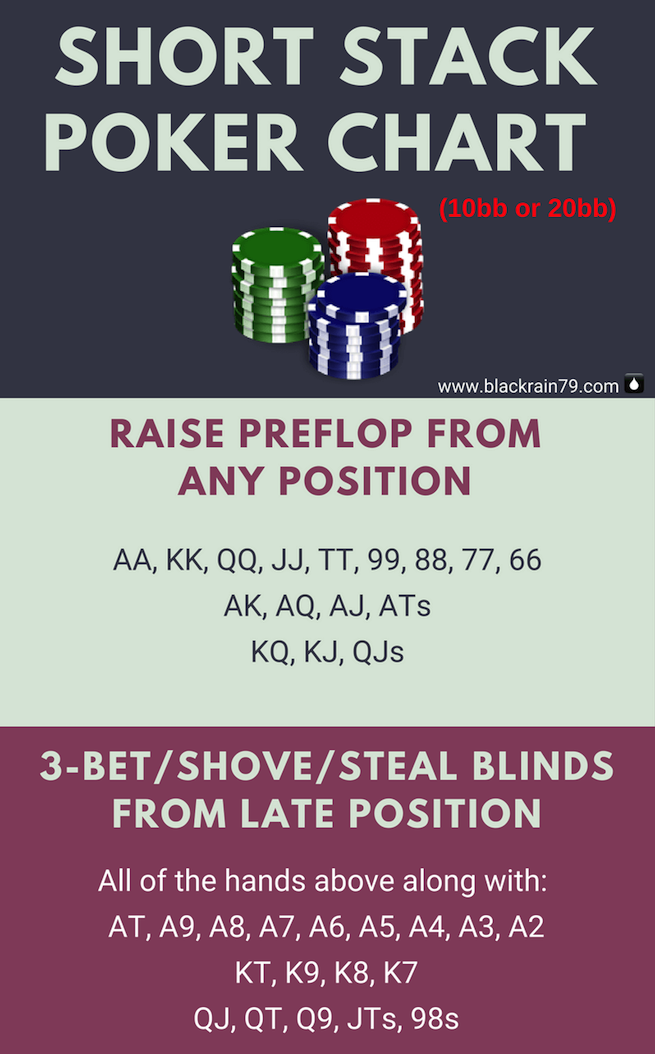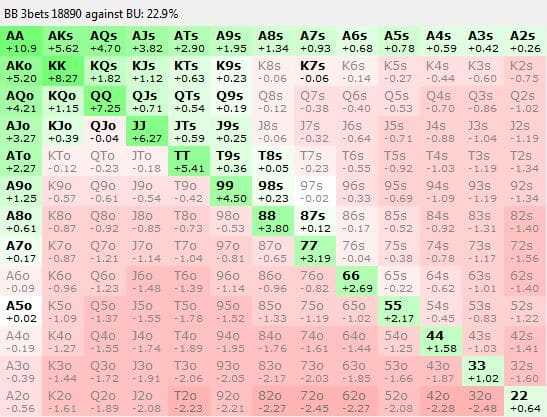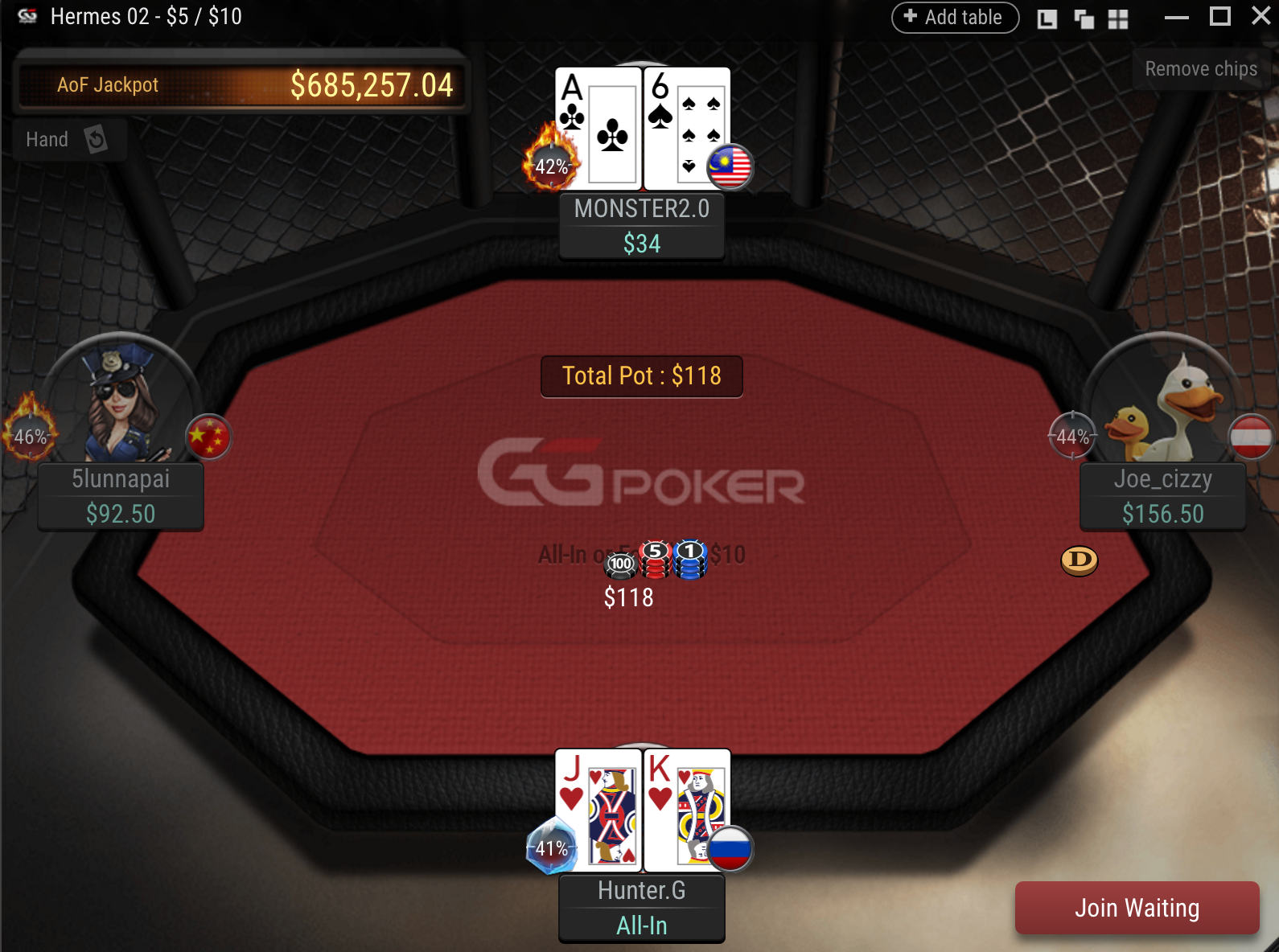Short Stack Cash Game
After the flop you usually won’t have much left in front as a short stack so when you hit top pair with a strong kicker you should be thinking about getting all your money into the pot. If you run into a better hand, that’s poker, especially short stack poker. When the money goes in there are almost always outs to make the winning hand.
- There are a handful of different types of short stackers in cash games. The most common form of short stacker is the total amateur who just doesn’t know any better. This is the type of player that you want to be facing as they are the most likely to donate their chips without putting up much of a fight.
- The best short stack poker strategy is to play tight preflop, fold all speculative hands like suited connectors and suited aces, bet small postflop with both your bluffs and your value hands, play your draws fast and use the squeeze play often. These are some of the most important parts of a good short stack poker strategy.
Mark Poker Articles, Poker Projects
“Easy come easy go” seems to be the story of my life when it comes to reaching the magical 200$ poker bankroll. I was so close 3 sessions ago when I hit 197$, but I’m now down to 135$. As usual I have made a graph which clearly shows my dismal last 3 sessions.

Here’s how it happened (posts taken from my bankroll building thread on the PokerBRB forum)
Took a beating tonight
Not my best session hour ever. Lost 3 buyins (-24$) and my bankroll is now down to 171$
Lost with QQ against AK (turn and river were AK)
Lost with AA against AKs (turn gave my opponent the flush)
Lost with 910s on a A52 board (2 of my suit) against KK
Instead of playing on, I decided to stop for the evening. No point in continuing when I am mad about my losses.
Perfect example of the short stack strategy in action
I look down at KK in early position and raised 7xBB to 3,5$. I get 2 callers.
The flop is 10 8 K, two spades. I go all in with my remaining 4,5$ and get one caller with QJ
Perfect, I get the money in as favorite which will make me a winning player in the long run.
Not tonight however since the river was an A
My bankroll is currently free-falling….
Money Cash Stacks
My intuition screams at me: “FOLD, FOLD, FOLD, FOLD…..FOLD you idiot”
What do I do? I call…he flips QQ and I’m down 2.5 buyins tonight.
My bankroll was soooo close to 200$ and now it’s down to 155$.
Unbearable I tell you…unbearable. I need a poker break to re focus.
I guess I can only blame myself. Twice I reraised an initial raiser all in with pocket sevens because I was convinced they had high cards.
It turned out that they had high pairs, QQ and KK respectively.
I also lost with AK against QK.
My netprofit of 125$ has been halved in 3 sessions.
Sucky Sucky is my only comment….
Similar Posts:
The joys of poker, what goes up, must come done. Keep your head up and you will turn this thing around just like you did the first time you started playing the Short Stack Strategy.
I does seem that your bankroll is a bit small to your limits. Loosing 25% of the bankroll on one session seems a lot. Have you considered moving one level down? You could try to increase the number of tables so that your “investment” is the same size. Just an idea. Good luck!
Even with a shortstack strategy you should be buying in for only 2% of your bankroll on any given cash game. That’s the most important piece of bankroll management you could exercise.
Poker is gambling (even with a sound strategy) so you need to protect yourself from variance.
Leave a comment
Special promotions
Poker Pro Bankroll Series
Latest Poker Strategy Articles
Contact PokerBankrollBlog
Doyle Brunson said, “The key to no limit . . . is to put a man to a decision for all his money.”
Poker players who have studied the game know this. They will be looking for chances to put you to such a decision.
One way to make that decision easier is to play with a short stack, 30BB or whatever the minimum buy in is.
1. Experts advise against playing with a short stack in microstakes cash games
The overwhelming majority of poker experts strongly recommend buying in with and maintaining a stack size of at least one hundred big blinds (100BB).
Experts say it is the optimum stack size for two reasons:
Buying in for less than a full stack limits your potential winnings when playing against a recreational player with a full stack of chips he expects to lose.
100BB is the maximum buy-in at many tables. So, when you buy-in for that, you start where everyone else starts.
Because of those two factors, most poker books, videos and blogs are about cash games is geared toward this stack size. That in itself is another reason to learn and play a full-stack strategy – more material to learn about it.
2. Why would a micro-stakes beginner want to play the short-stack strategy?
One expert, Ed Miller, teaches how to play with a variety of stack sizes and often recommends a smaller stack size.
Miller’s strategies allow you to work with whatever size you happen to have, so that you can start small and adjust when your stack grows.
My own opinion is that a small stack size is often the best size with which to start a session, especially while you are a beginner at the micro-stakes.
If you are a better player than the ones at the table, you will soon enough grow your stack to full-size, gathering information on opponents while you do.
Since many bad players play with a short stack anyway, starting with a big stack does you no good against them. Against a short stack, you have to play the short-stack strategy, because the effective stack is short.
Because bad players either buy in short or buy in full and watch their stacks dwindle without topping off, most tables on which you will want to play will have a variety of stack sizes.
So you should develop the skill of playing against any size or with any size.
3. What is the cash game short stack strategy?
There are several versions.
Here are the basics of the very simplified 30BB short-stack cash game strategy:
You patiently wait for a big pocket pair or ace-jack plus, or KQ, then raise strongly pre-flop. If you flop an over-pair or top pair/strong kicker, or a very strong draw, you push all in.
4. The math of the short stack cash game strategy
The math of short stacking is that when your stack is small (or when you are up against only short-stacked opponents), your risk to reward ratio in any given pot is less.
Suppose you are on the big blind in a micro stakes 10NL game with a $3.00 stack.
Action folds to you. You have:
Q♥Q♠
You raise to $0.30. The small blind folds. The big blind 3bets to $1.00.
You call. The pot is now $2.05 and your stack is $2.00.

 The flop comes:
The flop comes:9♦J♣8♦
The button bets $1.50, roughly 75% of the pot. That is an easy call with an over pair plus a gutshot. You have almost no reverse implied odds. In fact, you should just shove in your $2.00 stack.
A villain who 3bet pre-flop would likely c-bet this flop with many hands that you are beating, such as ace-jack, ace king, ace-queen, a diamond suited ace, and king-queen.
The only likely 3bet hands beating you at the moment are AA, KK, JJ, 99 or 88 for a set, or J9 suited or 98 suited for two pair.
His flop c-bet brings the pot up to $3.55. You only have to call $1.50. The pot will pay you 2.36:1 and you estimate that you have a better than 1:1 chance of winning it.
Whatever the turn and river bring, you made a correct call on the flop.
5. Let’s replay the same hand with a full 100BB stack ($10.00) instead of a 30BB short-stack:
You raise pre-flop with your pocket queens and call Villain’s 3bet. The pot is $2.05.
The flop comes with the jack and the draws and you call the same $1.50 raise. The pot is now $5.05 and you have $7.50 left.
The turn is:
9♦J♣8♦4♦
Villain bets out $2.50, about half pot. What do you do?
If you are at the microstakes, you would have one minute to decide before you are auto-folded. Pause for exactly one minute to make up your mind and then move on the section on psychology.
One Mississippi, two Mississippi, three Mississippi . . .
Are you struggling to beat small stakes poker games? (read this)
Are you still having problems turning a consistent profit in low stakes poker games online or live? Are you looking to make a solid part time income playing these games?
That is why I wrote this free little 50 page poker cheat sheet to give you the exact strategies to start consistently making $500, $1000 (or more) per month in low stakes poker games right now.
These are the exact poker strategies that I have used as a 10+ year poker pro. And I lay them all out for you step by step in this free guide.
Enter your details below and I will send my free poker cheat sheet to your inbox right now.
6. The psychology of the short stack strategy
Your thought process in that situation should go like this;
‘If Villain has two diamonds, I’m drawing dead. If he is betting again with AJ, I’m golden! If he has 98 or J9, I’m behind but I have outs to beat him
‘If I call the $2.50, the pot will be $10.05 and I will only have $4.50 left.
If he has the flush, especially the ace high flush, he will certainly jam the river on any card. If he has two pair, Villain will likely check to pot control.
‘But since I’m taking so long to decide now, he may also bluff-jam the river with AJ with one diamond that missed or with a straight draw that missed.
Yes. He will jam the river with whatever he has. What the heck should I do? ‘I feel as though I’m being put to a decision for all my money!’
No matter how strong your single pair is, an opponent can put you to a tough decision when the board is wet, connected or paired by representing a nut hand.
If you always fold in that situation, your opponents can bluff you every time a scary board appears. If you call every time, you will be a calling station when opponents do get the nut hands.
Short Stack Cash Games Starting Hands
The upside is that with a full stack, you will also be able to make things tough on your opponents by appearing to be going after their whole stack.But it takes experience and study to know when to do that. I would argue that whether a full stack or a short stack is better for you to play with depends greatly on your skill level.
A short stack allows you to confidently play your strong pair hands (big top pair, strong kicker and big over pairs), while a full stack allows you to play drawing hands for bluffs and for value if you fill your draw.
Since your range with a short stack is so tight, it is a good way for a beginner to practice disciplined play. This is something that Daniel Negreanu actually recommends in his MasterClass.
Learning to wait for big pairs and double broadways will make it much easier when you full-stack waiting for baby pairs, suited aces and suited connectors in favorable spots.
7. How to use the short stack strategy at the microstakes
My favorite microstakes tactic is to start with around 30BB, playing a very tight and aggressive short stack strategy. If if I double up, and the table is fishy, I keep playing with around 60BB.
By then, I have information on the opponents and more chips with which to exploit them, so I can expand my range and throw in some bluffs.
Doubling up is less likely at that stack size, but by loosening up a little and increasing aggression, I win more small pots.
The short stack strategy allows you to represent yourself as a fish when you first sit down.
I like to buy-in with an odd amount, such as $3.43 at 10NL. I may look like a fish on his last few dollars in his account, or in the session.
I use the “extra” forty-three cents to deliberately limp-fold the first two hands and to steal-fold the first time I’m on the button.

If I do that my first orbit, villains who are paying attention to the new player will mistake me for a weak-loose player who scares off his hands easily.
Exactly the image I want if I wake up with a big pair or AK in the next couple of orbits.
Stacks Of Cash Image
8. Does this short stack strategy really work at the micros?
Obviously, I’m going against a lot of experts on this one, so take my advice with a grain of salt.
My only evidence is that it has worked for me. The cash game short-stack strategy let me earn with big pairs while I learned to play drawing hands.
If you want to try it, remember that you get three short stack buy-ins for the price of one full stack buy-in. That should be enough to tell you in one or two sessions whether the short stack strategy is for you.
Keep calm and re-buy!
Lastly, if you want to know my complete strategy for crushing the microstakes, make sure you grab a copy of my free poker guide.